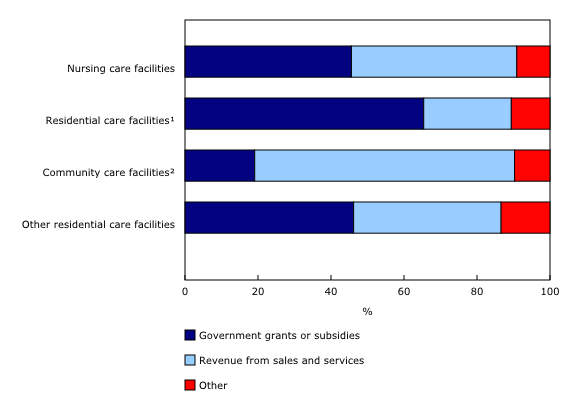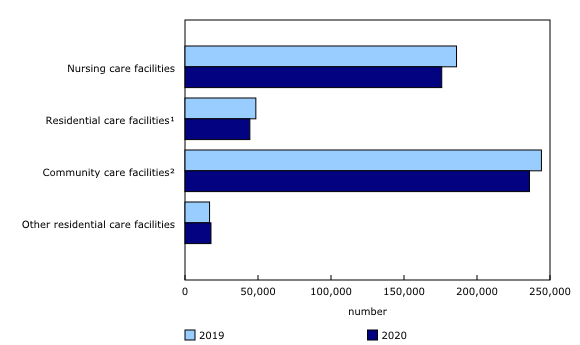Nursing and residential care facilities in 2020
Released: 2022-11-02
Canada's nursing and residential care facilities were adversely impacted by the COVID-19 pandemic in 2020. The number of employees in this subsector dropped 2.1% year over year. The number of residents in this subsector on the last day of the fiscal period fell 4.3% year over year, primarily due to fewer residents in nursing care facilities and community care facilities for the elderly. This decrease was largely driven by fewer admissions to those facilities.
Of the 9,150 facilities represented by the Nursing and Residential Care Facility Survey, 2,079 were nursing care facilities; 2,745 were residential developmental handicap, mental health and substance abuse facilities; 3,138 were community care facilities for the elderly; and 1,188 were other residential care facilities, such as transition homes for women.
Government subsidies are important for nursing care facilities
Revenue from sales and services made up half (50.3%) of the total operating revenue in nursing and residential care facilities in 2020. In comparison, government grants or subsidies made up 39.9% of the total operating revenue in the subsector for the same period.
In 2020, government grants or subsidies were the largest source of revenue (45.6%) for nursing care facilities, followed closely by revenue from sales and services (45.3%). Government grants or subsidies accounted for over half of the total operating revenue in nursing care facilities in Ontario, Saskatchewan, Alberta and British Columbia.
Meanwhile, revenue from sales and services (71.2%) was the primary contributor to operating revenue for community care facilities for the elderly in 2020, while government grants or subsidies (19.1%) were a distant secondary contributor.
In all provinces, revenue from sales and services accounted for over half of the total operating revenue in community care facilities for the elderly.
More direct care employees despite loss of nurses and physicians
The number of employees in nursing and residential care facilities fell 2.1% to 495,680 in 2020. In nursing care facilities and community care facilities for the elderly, where 81.1% of the employees in this subsector worked, the number of employees was almost the same compared with 2019, up 0.2%.
In nursing care facilities, the number of employees remained relatively stable (+0.3%), at 257,680 in 2020. Despite an overall increase in direct care employees (+1.3%), the number of nurses dropped to 59,190 and the number of physicians fell to 1,390. The loss of nurses and physicians was due to fewer part-time, casual and contract nurses and physicians. The increase in direct care employees was partly offset by a decrease in indirect care employees (-10.4%), most of which were full-time employees.
In 2020, in community care facilities for the elderly, the number of employees also remained relatively stable (-0.1%), at 144,475. Similar to the trend in nursing care facilities, community care facilities for the elderly reported fewer indirect care employees (-20.7%) and more direct care employees (+3.7%). Unlike nursing care facilities, the decline in indirect care employees outweighed the increase in direct care employees in community care facilities for the elderly. Mirroring the phenomenon in nursing care facilities, the number of nurses in community care facilities for the elderly fell to 18,065, driven by fewer part-time and casual nurses.
Changes in hours worked vary by province and by facility type
In 2020, nursing care facilities reported increased hours worked in seven provinces. The largest increase came from Ontario (+3.2%). Nearly half of nursing care facility employees are located in this province, and their total number of hours worked reached nearly 124 million. This growth was attributable to more employees in nursing care facilities (+3.8%). In contrast, both the hours worked and the number of employees in community care facilities for the elderly in Ontario declined.
Meanwhile, community care facilities for the elderly reported fewer hours worked in six provinces in 2020. The largest decrease came from Alberta, where the hours worked dropped 8.5% to 23.0 million in the same period. This decline was not reflected in the number of employees, which increased (+4.6%), indicating fewer hours worked per employee on average in Alberta's community care facilities for the elderly. However, both hours worked and the number of employees in nursing care facilities in Alberta increased.
Decrease in residents driven by fewer admissions in nursing care facilities and community care facilities for the elderly
In 2020, the number of residents in nursing and residential care facilities on the last day of the fiscal period fell 4.3% to 474,000. This decrease was driven by fewer residents in nursing care facilities (-5.4%) and community care facilities for the elderly (-3.4%).
The decline in the number of nursing care facility residents in 2020 was predominantly due to fewer admissions, which were down 23.3% to 80,575. The decline was partly offset by fewer non-death discharges, which fell 30.1% to 33,540. The ratio of non-death discharges to total residents under care (residents present in the facility on the first day of the fiscal period plus residents admitted during the fiscal period) in nursing care facilities fell 3.9 percentage points to 12.4%. The lower ratio indicates a lower proportion of residents leaving the facilities due to reasons other than death. Meanwhile, the ratio of deaths to total residents under care increased by 1.8 percentage points to 22.5%, indicating a slightly higher death rate among nursing care facility residents. The total number of resident days in nursing care facilities fell 7.2% to 62.1 million.
The decline in the number of residents in community care facilities for the elderly in 2020 was also due to fewer admissions, which fell 18.1% to 58,365, combined with increased discharges (+2.6%) due to more deaths (+9.5%). The ratio of non-death discharges to total residents under care in community care facilities for the elderly increased by 0.2 percentage points to 15.5%. Meanwhile, the ratio of deaths to total residents under care increased by 0.7 percentage points to 7.3%, indicating a slightly higher death rate among retirement home residents. The total number of resident days in community care facilities for the elderly fell 1.5% to 80.4 million in 2020.
The number of residents in nursing and residential care facilities on the last day of the fiscal period fell in nine provinces in 2020, led by Ontario. In contrast, the number of residents in Manitoba increased by 1.0%.
In 2020, by gender, the proportion of female residents in nursing care facilities (64.3%) and community care facilities for the elderly (66.7%) dropped 0.7 percentage points and 1.2 percentage points, respectively. By gender, the proportion of male residents in nursing care facilities (35.6%)and community care facilities for the elderly (33.0%) increased by 0.6 and 1.1 percentage points, respectively.
Beds decrease in nursing care facilities and increase in community care facilities for the elderly
The total number of beds in nursing care facilities and community care facilities for the elderly combined increased 2.5% to 455,480 in 2020. Despite a loss of 2,255 beds in nursing care facilities, 13,150 beds were gained in community care facilities for the elderly.
In nursing care facilities, the decline in the number of beds represented a loss of 1.2% year over year. In this industry group, the number of beds fell in four provinces in 2020, representing 71.0% of total beds in nursing care facilities in Canada. The decline was led by Ontario, which reported 3,965 fewer beds. This decrease was partly attributable to provincial directives, first announced in June 2020, which aimed to eliminate admissions to three- and four-bed rooms in long-term care homes. Nursing care facility beds in Manitoba increased the most, at 1,255 additional beds.
In community care facilities for the elderly, the increase in the number of beds represented a gain of 5.2% year over year. The number of beds rose in most provinces in 2020, led by Quebec and Alberta. The exceptions to the increase were three Atlantic provinces (Newfoundland and Labrador, Nova Scotia and Prince Edward Island), which decreased by less than 2.0% each.
Services
Many services, particularly hearing care (-19.1%), eye care (-13.2%) and cultural or religious services (-12.9%), were offered in fewer nursing care facilities and community care facilities for the elderly in 2020. Meanwhile, social activity programs were offered in more facilities in these two industry groups (+12.1%) in 2020, especially among community care facilities for the elderly (+21.0%). For each of these two industry groups, nursing care, physician care (only in nursing care facilities), meal services, help with activities of daily living and housekeeping either increased or decreased by no more than 5.0% in 2020.
Note to readers
These are the first full dataset results from the 2021 Nursing and Residential Care Facility Survey, which collected information on facility and resident characteristics for the fiscal year ending from April 1, 2020, to March 31, 2021, as well as information on the COVID-19 pandemic up to and including December 31, 2021.
This survey was a partnership between Statistics Canada, Health Canada, the Public Health Agency of Canada and the Canadian Institute for Health Information.
A microdata file is available for analysis, allowing governments, policy makers and researchers to understand the links between facility characteristics and operations, employees, health outcomes of residents, and system-level performance.
Quebec public facilities did not participate in the most recent iteration of the survey.
For financial estimates on public nursing and residential care facilities, please refer to Table 13-10-0101-01. Please see Table 13-10-0102-01 for financial estimates of private nursing and residential care facilities.
Results of this survey pertaining to COVID-19 were released in September 2022 in an article entitled "Impacts of COVID-19 on Canadian nursing homes and seniors' homes in 2021."
Information on the pandemic experience in the long-term care sector can be found at the Canadian Institute for Health Information.
Contact information
For more information, or to enquire about the concepts, methods or data quality of this release, contact us (toll-free 1-800-263-1136; 514-283-8300; infostats@statcan.gc.ca) or Media Relations (statcan.mediahotline-ligneinfomedias.statcan@statcan.gc.ca).
- Date modified:


